You are not logged in.
- Topics: Active | Unanswered
Pages: 1
#1 2011-09-24 14:22:03
- Jon_Spencer
- Member
- Registered: 2003-11-23
- Posts: 162
ALBERTINE's Log (F34)
This is the web page for the Frances 34, Albertine, and her owners, Jon and Lynda Spencer.
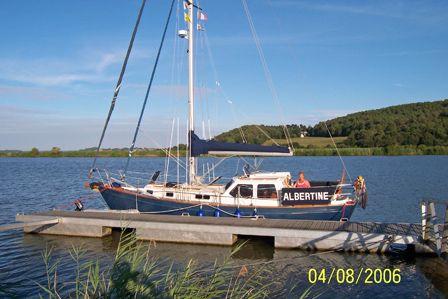
Albertine in 2006
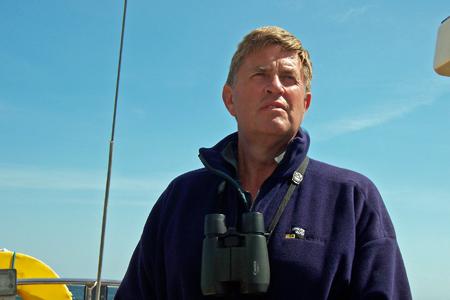
Jon Spencer
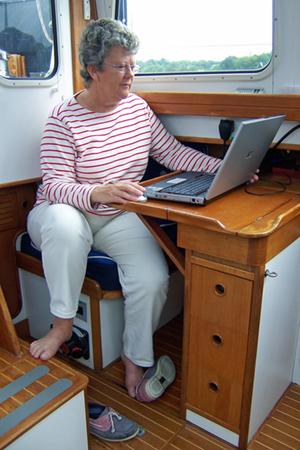
Lynda Spencer
Offline
#2 2011-09-24 14:27:21
- Jon_Spencer
- Member
- Registered: 2003-11-23
- Posts: 162
Re: ALBERTINE's Log (F34)
Albertine's First Year In New Ownership
It was in September 2003 that Albertine caught our eye as we wandered through the Universal Boatyard on the River Hamble. She was propped up and almost ready for the Used Boat Show at Swanwick and her lines and potential comfort, offered by the pilothouse, could not be ignored. A quick phone call to Stephen Constable, the Victoria Broker, put us in contact with Barrie Marson and we were well on the way to ownership.
That first Autumn and Winter saw her in full use from her snug berth at Whale Island in Portsmouth Harbour where the potential pilothouse comfort became a reality. We were almost embarrassed at the overuse of the autopilot and on-board heating but the guilty feeling didn't last long! On New Years Eve we entertained friends onboard to supper before walking up from the pontoon to Warsash Sailing Club to party into the early hours. Our return to Albertine found her pressed to the pontoon with lines taught in a strong south-westerly. However, we still managed to enjoy a comfortable night on board thanks to the heater.
The Spring found us at Ginn's Farm on the Beaulieu River with other Victoria's and Frances' and the excellent company of their owners. In early June the Royal Navy Sailing Association Rally at Ouistreham seemed an excellent excuse for our first Channel crossing in Albertine via Cherbourg and St Vaast-La-Hougue. We planned to cruise along the invasion beaches prior to the weekend's liberation celebrations during which the weather could not have been more variable. Fog and driving rain to test the GPS around the shoals off Barfleur and the lightest of conditions to carry us along the coast, under the cruising chute, and into the remains of the Mulberry Harbour at Arromanches. The cruising guide recommended not anchoring and the apparently very uneven bottom indicated wartime wreckage over a very wide area. We only just made this lunch stop, and very memorable moment, as the following day the whole area was closed in preparation for the arrival of the various Heads of State.
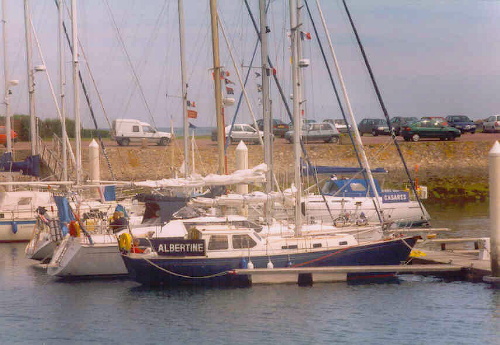
Albertine at St Vaast
We spent an excellent and enjoyable weekend of memorial services, military displays, including a battalion (600 men) parachute drop over Pegasus Bridge on the Caen Cannel, and liberation parties. For us the most poignant moment was the firework display for which these words will paint a very inadequate picture. We sat on the seawall at Ouistreham looking east down the 50 miles of invasion beaches. There were 26 identical and simultaneous displays of which we could see many mirrored within each other. Usually at firework displays, there is plenty of spectator reaction but at this re-enactment of the pre-dawn bombardment, there was silence. As the smoke spread across the beaches, the spectators were silhouetted against the exploding star shells and the sight must have been much as it was some sixty years before; very spooky. We had access and timing problems arranging our departure passage through the sea lock at Ouistreham, which resulted in the need for a night passage plan maintaining six knots for a dawn landfall at the Nab Tower. With just a little assistance from the engine, we made it back to our berth just in time for a rather jaded day at work!
During the Summer, Richard our son, was added to the crew manifest and we set off via Cherbourg and the Alderney Race for St Helier. Conditions were light, which did nothing for the sailing, but the mackerel fishing was good. Having kept well to the east through the Alderney Race we spotted a huge sun fish basking on the surface as we were off to the east of Sark. Its dorsal fin was lazily flapping from side to side and as we slowly passed it rolled over on its side and gave Albertine and us a watery stare.
Our stay in St Helier was short as the following morning we set off under motor for Granville. While stemming the last of the tide off the Violet Bank we picked up a plastic woven sack on the propeller. Thank goodness Barrie had fitted rope cutters which dealt with most of the problem until Richard could dive below and pull the remainder from the shaft. We found Granville delightful with beach and other facilities all close at hand. With low spring tides during the afternoons we were able to join the bulk of the local population with nets and hooks to seek out all that was edible from amongst the rocks, while reminding ourselves of some of the off-lying dangers at very close range.
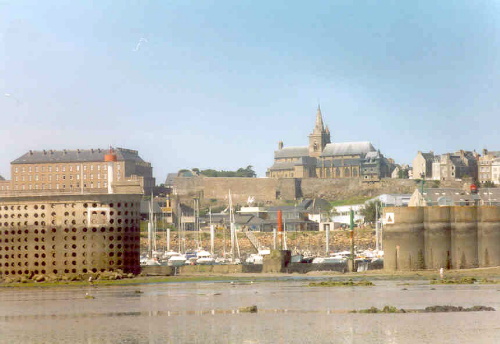
Granville at low tide
After three days, and with Lynda confined to her bunk with a tummy bug (or was it the Moules and Frites the night before!), we set off for St Malo under cruising chute. With the tide under our keel and in company with two gaffed rigged Breton fishing boats we spent an enchanting day. The passage plan to the Grand Jardin lighthouse indicated 23 miles but as we picked up the waiting buoy outside the Bassin Vauban the log recorded only 10. Thank goodness for favourable tides. The walled city as always was vibrant, noisy and great fun but after a couple of days, Richard had to return to work via the ferry. We locked through the tidal barrier and into the River Rance for a week.

Breton Classics on passage to St. Malo
It was our first trip into these sheltered waters and with neap tides, we were able to enjoy them to their full extent. I armed myself with as much local information as possible, but even so the man-made tidal arrangements, caused by the hydroelectric plant, caused us one or two interesting moments. The first night, we anchored off Le Minihic-S-Rance in almost 9 metres. We swam, showered and were watching a pair of green woodpeckers collecting their supper from the low cliffs when the water level began to fall dramatically. Within the hour and with supper on the table in the cockpit, it had dropped by 4 metres and sandbanks were beginning to appear where none were charted. With confidence in my self-made tidal curves and other moorings and boats close at hand, we held our breath until we were left surrounded by seagulls, herons and egrets turning the shellfish and hunting for small fish in the puddles on the sandbanks, and crested grebe and divers making the best of the 2 metres under our keel. It was fine during neaps but springs might have had a very different outcome.
Further upstream and under the first two of three bridges, we spent a night in the Marina at Plouer. The little village was only a short walk up the hill which we enjoyed in the evening sunshine but avoided the following morning by having our croissants order delivered to the very helpful lady Harbour Master. We left the following lunchtime and carried the tide further up to the Chatelier Lock passing between tree laden slopes and fishing huts with very little water under the keel. Just beyond the lock, Lyvet Marina provided us with a very snug outboard berth. Ahead Dinan beckoned but with the charted depth right on our limits and low cables with only a few inches air clearance above our mast we decided to row the tender up stream and have lunch in the ancient walled city.
After 6 miles and 3 hours of rowing, we discovered that the cables now ran under rather than over the river; so much for the pilot! On our return passage, we sighted a magnificent Peregrine Falcon enjoying the evening sunshine on a bluff high above the Lyvet Marina and spent a good time trying to get closer and closer. It is very easy to fall into the laid back ways of the inland waterways but time was pushing on and we had to return to St Malo and prepare for the voyage back to British waters. The trip back to St Malo was uneventful in freshening winds we picked up vacant buoys at St Suliac and La Jouventre for undisturbed nights and without the worry of anchored depths or dragging onto a lee shore. By the time we arrived back at the Vauban Bassin, and with a gap of 60 years, the liberating armies had reached St Malo from their Normandy invasion so we enjoyed yet more celebrations and firework displays.
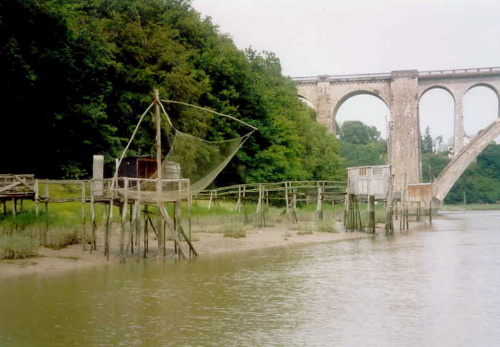
Fishing nets on the Rance just below Chatelier Lock
Our return to St Helier was west about the Plateau des Minquier's and entry through the Danger Rock Passage where we had to work hard to keep the leading marks in transit in a strong flooding tide and amid breaking and swirling water to port and starboard. It all looked far worse than reality, but great fun with plenty of water under the keel. After detailed planning and complete with a day bus pass we visited Gorey Harbour, the Corbiere Lighthouse and all the bays and vantage points around Jersey and promised ourselves to return and explore the seaward approaches another year.
With worsening weather forecast for later, we took the opportunity in a brisk south- westerly to close the gap on Portsmouth and make for St Peter Port. Instead of increasing, the wind, which had been a steady force 5, dropped to nothing and we had to engage the engine off St Martin's Point in order to stem the tide and have a comfortable lunch moored alongside the visitor's pontoon. The following day the weather worsened still further with heavy winds and driving rain so passage plans were reviewed and yet another trip into the delights of Island and pre supper drinks at the Royal Guernsey Yacht Club, to be greeted by members from our Club at Warsash, on a day visit to the Island in search of a new boat. The following morning dawned with bright sunshine, a rising barometer and favourable reports from Jersey Radio and so we headed off up the Little Russell under just half the Yankee and at almost hull speed. The simple plan was to head for the south-western tip of Alderney before heading north-east past Cap de la Hague and round to Cherbourg and thereby miss the worst of the overfalls.
However, because we missed the first of the tide from Guernsey we caught the first of the back- eddy at La Plate north cardinal mark going in the opposite direction. We had been sat in the cockpit chatting away and holding on tight with ten foot standing waves on our stern when we realized it was taking some time to round the headland, we checked the SOG only to find that we were not doing the 6.5 knots that we thought but less than one. We unrolled some more of the Yankee and put on the engine but were still only able to stem the increasing tide by just over a knot, we gradually clawed our way along to Omonville-la-Rogue, calmer waters and supper in Cherbourg some several hours later than anticipated. Another lesson learnt onboard our patient and forgiving Albertine.
The following day was spent stocking the cellars and climbing the hill behind the town to the museum and taking in the magnificent views. For those of you that enjoy just watching the tide ebb and flow there is a small water feature outside the museum which encapsulates the whole tide process in about five minutes and kept us fascinated for 36 hours of tide-time. Charlie Dimmock, eat your heart out. Our final supper, which was excellent, was taken at the Yacht Club right by the Port de Chantereyne Marina and we both wondered why we had never eaten there before. I recommend it. The following day in a moderate north-westerly we headed home to Portsmouth on a crystal clear day during which we were only out of sight of land for a couple of hours mid-channel.
The following weekend being the late August Bank Holiday we headed for Poole Harbour to lay at anchor behind Goathorn Point with lunch on Sunday taken in Studland Bay. From there in a strong south-westerly and under Staysail only we reached Yarmouth via the inshore passage and onwards Portsmouth in easing conditions on the Monday.
With Albertine looking after us so well round Cap de la Hague, and in other blustery conditions throughout the season, we paid little attention to the strong wind warning for the final south coast rally of the season at Yarmouth. However, we had forgotten the dreaded Solent chop and therefore after battling up past Cowes, with breaking water to the horizon and the strong wind warning turning to gale force on the Sunday we turned and headed for home and the Southampton Boat Show on Sunday. Needless to say, as soon as the decision had been made we sighted a fully reefed Cadenza still Yarmouth bound. Albertine's pilothouse has obviously weakened some of our resolute determination for hard weather sailing during the season, but it is very comfortable!
Offline
#3 2011-09-24 14:35:50
- Jon_Spencer
- Member
- Registered: 2003-11-23
- Posts: 162
Re: ALBERTINE's Log (F34)
The Retirement Cruise
It does not seem that we have been planning and preparing for this new adventure for over eighteen months but having taken the plunge, downsized from our house to a small apartment, and resigned from our jobs, we had little choice but to escape to a more simple life aboard Albertine.
Our plan was to head off over the horizon to the south and beyond, towards the end of May, on a modest cruising budget of £1,000 per month. The question was whether the plan was achievable and how many sacrifices to our intended lifestyle would we have to make on the way.

Sunrise over the Needles
The outline passage plan included visiting some of our favourite haunts along the North Brittany coast before exploring the Gulf of Morbihan, in West Brittany, in July. Here we would meet up with Mike and Anna Pinder, who would be in Vannes for a twinning event, and eventually arrive in Bordeaux by the end of August. Here we would un-step the mast and prepare it for overland transportation to the Mediterranean coast before heading up the Garonne, and the Canal Lateral a la Garonne to the Canal du Midi. The Spring of 2007 should see progress around the islands of Corsica and Sardinia and across the bottom of Italy’s boot with Summer spent mainly at anchor in the Dalmatian Islands. As the autumn temperatures arrive we will drop further south into Greek waters before making the decision on whether to return home for the festive season and family visits and responsibilities. Provided that we can arrange the necessary visas we hope that the Summer of 2008 will find us in the Black Sea and down on the North African coast by Winter.
As with all plans change is inevitable, but we had not expected to have to delay our departure from Warsash for the first leg to Lymington due to very unseasonable south-westerly and westerly gales sweeping down the Channel. The ill wind did however enable us to enjoy the Raymarine Warsash Spring Series Prizegiving and an excellent supper with our committee boat team of Paul and Sarah Royds-Jones and Mike and Norma Parkins. We eventually departed only a few days late, but with at least three years to make up the delay, it was not a crisis.
We planned to leave Warsash Sailing Club pontoon, on the River Hamble, in the early morning of the 29 May and head to Cherbourg via Bembridge Ledge arriving in the early evening. However, excitement got the better of us and at 0230 we were casting off under a star studded sky and taking the strong ebb down towards Yarmouth and the Needles. Just over two hours later, dawn saw us at the Needles Fairway buoy with the lighthouse and rocks set against the rising sun. The wind as expected was a Force 4 to 5 from the North West but there was still a lumpy sea running from the South West so we corkscrewed across the sea in a most uncomfortable fashion. Lynda is usually of stout constitution but it was not long before she was taken by the “mal de mer” leaving Jon to single hand his away across with adequate assistance from the Raymarine autopilot. We arrived in Cherbourg some 15 hours later and in good spirits but ready to turn in. Imagine our surprise on waking to find David and Mary Greenway, other Warsash Sailing Club members along side in “Pavo” but still turned in. We headed off shopping to return to find David and Mary scrubbing their topsides which included their waterproof suits.

David giving Mary the 'Brush Off'
Two days later we were heading for St Peter Port on Guernsey via the Alderney Race. We were a little early with our arrival at Cap de la Hague and instead of being gracefully drawn into the Race at just past slack water we had another lumpy ride towards Alderney trying to avoid the worst of the overfalls for which the Race is justly known. A brisk wind from the West prevented us making enough ground in that direction before we were drawn into the northern edges of the Banc de la Schole. The small standing waves were not too much of a problem for our comfortable pilot house but it was just the moment when David and Mary in their thoroughbred racer decided to power past doing at least twice our speed. We should have been embarrassed but we were using cruising to conceal our lack of cutting edge sailing prowess.

The Greenways overtaking on the way to Guernsey
Albertine arrived in St Peter Port at least two hours after Pavo but by the following early morning we were off again South leaving David and Mary to return to the North and work the following week. Was this the first benefit of our retirement cruise?

Offline
#4 2012-01-06 20:21:34
- Jon_Spencer
- Member
- Registered: 2003-11-23
- Posts: 162
Re: ALBERTINE's Log (F34)
The First Month South - Part 1
The following morning, on the last day of May, we cleared Castle Point before 0700 and with Main and Yankee set to catch the light North Westerly wind we headed South under a clear sky and in good visibility.

St. Martin's Point on Guernsey
Saint Martin’s Point light on the South Eastern corner of Guernsey was to be our last sight of home, and it was not long before the tide was carrying us towards the Plateau des Roches Douvres, which we left to port allowing the tide to carry us clear of any off lying dangers, and down towards Perros-Guirec. The leading bearing on the final approach to the Anse de Perros is 224° True, and that was also our clearing bearing from Saint Martin’s with not a single rock in the way!
Throughout the day the wind was to be frustratingly light and various sails were to be up and down with increasing frequency and increasing support from the engine. Twelve hours later, and in accordance with our schedule, we picked up one of the 15 visitor’s buoys in the lee of the Pointe du Chateau and had supper under a spectacular sunset.
We had only planned a very brief stop at Perros and the following morning, with a more relaxed day ahead of us we beat away from our mooring passing between the headland and Ile Tome and out towards Les Sept Isles.
Many years ago there had been a small Royal Marines Garrison on the islands and the old fort on Ile aux Monies was set in stark silhouette against the morning sky. In those past days the Garrison were tasked with keeping an eye on the French Fleet but today there were no lookouts watching our progress as we tacked up under the islands before heading back towards Ploumanac’h and the stunning pink granite coast.
The tide was setting us to the West with some speed and we had to tack out to sea again to ensure plenty of sea-room around the considerable offshore dangers around Tregastel before heading South down the narrow inshore channel to round up under Ile Milliau and pick up one of the waiting moorings before the rise of tide would allow our entry into Trebeurden.

Arriving Trébeurden
We had enjoyed Trebeurden before and on this passage had promised ourselves a week long break to catch up on the maintenance items that should have really been attended to before we left Warsash. The weather was brilliant with an Atlantic high dominating the area so we walked and lazed around including spending some time with Mike and Norma Parkins, from Warsash Sailing Club, who were on a short holiday in the area, and much of the outstanding maintenance was never attended to. The week passed all too quickly before the need to head West became pressing.
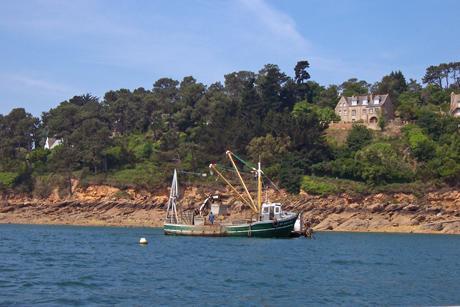
Shellfish boats at work off Pen Lann
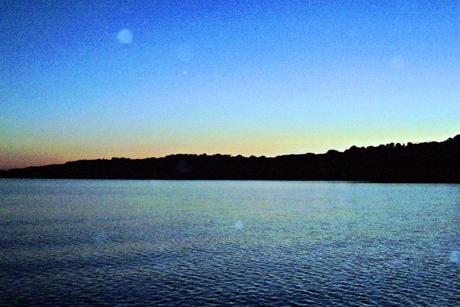
Sunrise over the Morlaix Estuary
The aim was to be at L’Aberwrach before the 12 June, which we judged was the optimum date for tackling the Chenal du Four, one of the world’s great tidal barriers. So determined to ensure that all our sailing was restricted to short and simple day sailing we set passage for the Bay of Morlaix but with no intention of heading up to the town. As with previous visits we picked up a mooring in the lee of Ile Louet under the picture-book lighthouse, having entered without incident or alarm via the Chenal Quest de Ricard. The wind had been steady from the North East all morning for our sail but as the afternoon wore on the wind freshened and with the tide rushing out of the Rade de Morlaix life on board became uncomfortable. Having missed the tide for the town we headed up to between Dourduff and Locquenole, where the Rade narrows into the Morlaix River, and dropped anchor in 6.4 metres. The comfort factor had improved dramatically and we were set for a quiet night with the prospect of at least 2 metres under our keel. The following morning we were up to watch the sun creep above the eastern bank of the Morlaix River and headed for the passage between Roscoff and the Ile de Batz.
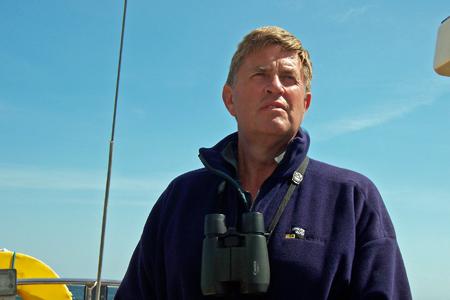
Concentration!

The lighthouse on the Île de Batz
As we cleared Pen Lann and a planned departure through the Grand Chenal we were reminded of the strength of the tides, and the need for maintaining a constant lookout for the various passing marks. Before we fully realised our mistake we had been set to the West as Ricard swept by to starboard rather than to port! The omens did not look good for the more demanding Chenal de Batz. Several of the port and starboard marks are only left by 70 metres, which at close quarters seems very close, but with most of the ebbing tide still under our keel, and our earlier mistake still fresh in our memories, we were swept through at over 7 knots and out towards the open sea with L‘Aberwac‘h some 30 miles ahead.
The light Easterly wind enabled us to make good progress under Main and Yankee, after initial help from the engine. The preventer, set from the boom via the bow and back to the safety of the cockpit, was essential as we began to feel the first effects of the Atlantic swell. The coastline appeared austere, compared with the apparent warmth of the pink granite further East, but it was not long before we had Ile Vierge lighthouse, which sits right on the North West tip of France, in sight.

Île Vierge lighthouse, L'Aberwrac'h
As is usual on all these passages we were in company with several other boats who appeared content to cut the corner through broken water while we remained further off-shore and away from the outer dangers.
However, we paid the price because as we approached the Le Libenter West Cardinal Mark the tide had set against us with some strength. We rolled away the Yankee, started the engine and I thought a couple of thousand revs would easily stem the tide but to no avail.
We came off the wind and with the Yankee pulling again started to make further progress through the water and over the ground. I thought the worst and wondered why our new rope cutters had failed to work or perhaps the propeller had fallen off. It was Lynda who noticed that I had managed to disengage the gear with my knee, so although I had the revs, we had no forward propulsion. Two frighteners in one day was almost too much but we were soon secure on the mooring buoys off La Palue and ready for a sundowner and supper.
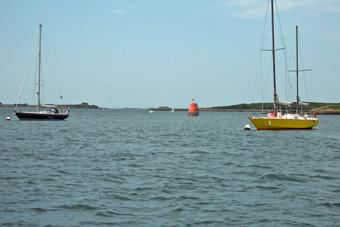
L'Aberwrac'h Entrance

La Mouette

L'Aberwrac'h Moorings
Most of those passing through L’Aberwrach do so only briefly but having arrived three days ahead of our schedule and with early morning mists enveloping the river estuary we decided to linger and explore some of the immediate hinterland on foot. It is easy walking out to the West through the extensive dunes at Saint Marguerite and once the mists had cleared the view out over the extensive rocky shoals were spectacular. Young people were enjoying the delights of dune buggy racing under kites, while we were content to stroll and watch the myriad of insects and butterflies amongst the bright purple orchids. The estuary also provided us with our first example of kelp being harvested from the rocks and brought ashore at La Palue, presumably for use by gardeners. Our stopover in L‘Aberwrach also gave us the chance to formally name Albertine’s tender Rose, by Lynda, who insisted that she will henceforth be affectionally known as Rosie.

L'Aberwrac'h - Looking down on Albertine

L'Aberwrac'h Church

The Naming of Rosie
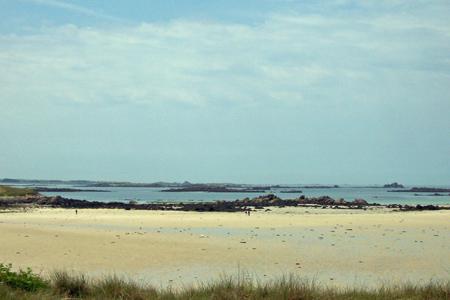
Across the islands from Presqu'ile Ste Margue
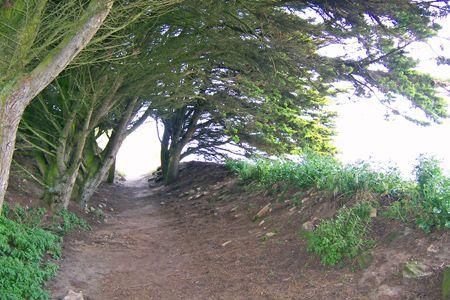
Windswept Trees
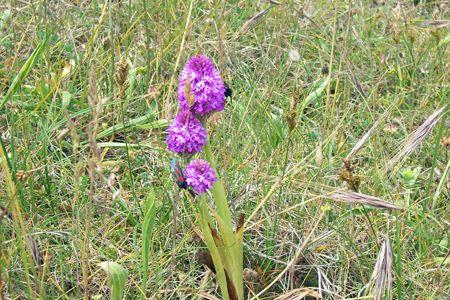
Wild Orchids
Finally after much detailed passage planning and preparations it was time to face up to the rigours of the Chenal du Four and we slipped away from our mooring in light North Easterly winds and a slowly rising barometer. We had not intended to tackle both the Chenal and the Raz at the same time and our passage would take us across the Rade de Brest and into Camaret were we arrived in the early afternoon after what turned out to be a very simple and undemanding trip with barely a ripple on the surface as we sped between the various marks within the close confines of the Chenal. For those, who like us have experience of misjudged timings at the Alderney Race, the passage is relatively simple provided the timing is right to take advantage of the first of the ebb when passing La Four Light and wind and tide is together.
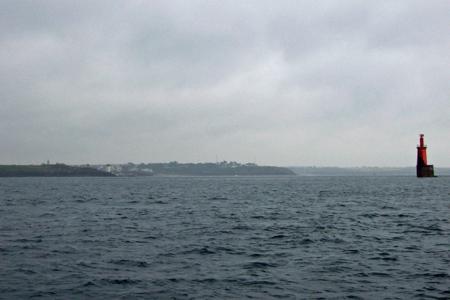
Les Vieux Moines, Chenal du Four

Pointe de Ste Mathieu, Chenal du Four

Approaching Cameret
Offline
#5 2012-01-06 22:12:36
- Jon_Spencer
- Member
- Registered: 2003-11-23
- Posts: 162
Re: ALBERTINE's Log (F34)
The First Month South - Part 2
Camaret was delightful and we moored in the Port Vauban alongside the inner part of the wave break. We again lingered and enjoyed some more spectacular walks which included sighting some of the immediate dangers that we would have to pass on our departure towards the Raz de Sein. We walked up to the Pointe du Toulinguet past over 100 menhirs (standing stones) forming part of a megalithic alignment, dating back to 2500BC, past the very fitting location for the French Merchant Marine Museum highlighting the Battle for the Atlantic, and finally to the huge granite Cross of Lorraine which is a memorial to the Bretons of the Free French Forces. It then seemed very appropriate as we looked back towards Pointe St Mathieu, at the Southern end of the Chenal du Four, that Naval elements of the NATO Standing Force Atlantic should steam in towards Brest in line astern. It’s not often that we see more than six capital ships, protecting the realms from such a spectacular grandstand.

Old boats in the harbour at Cameret
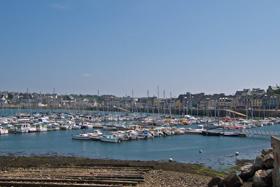
Inner Harbour, Cameret
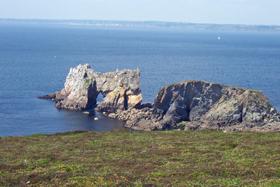
Rade de Brest from Cameret
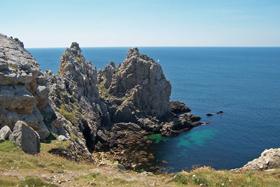
Over the rocks near Cameret

Memorial to the Bretons of the Free French
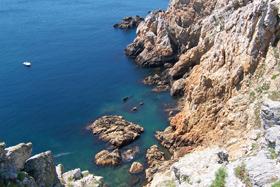
Rocky bay

Deserted beach

Lizard

Outer marina at Cameret

Rock strata on a deserted beach

On the deserted beach
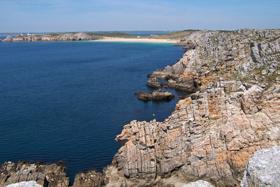
Towards anse de Pen-Hat

Looking out through the rocks

Leaving Cameret
We also enjoyed an simple evening in a café to listen to a group of Breton singers in cosmopolitan company and it was not long before we were dancing in the street. The activities drew quite a small crowd of onlookers many of whom were taking photographs of the antics of the merry dancers and amongst whom was Howard the vicar from Seaview on the Isle of Wight, but I could not put a name to the face until the following morning when we spotted him and his wife Jean having breakfast overlooking the harbour. We also met up with others from our Class Association in the form of John Cade and crew on board his Victoria 33, Cadenza, who we had bumped into earlier at Trebeurden, and Anne McQuade and Jenny on board her Frances 26, Greylag, from Mylor in Cornwall.
We should, as we were so close, have explored the Rade de Brest but we agreed on a more pressing engagement with the Raz de Sein and because we managed to get our timings, as suggested by Neville Featherstone, in his West France Cruising Companion, just right, we slipped into Sainte Evette with barely a splash on deck.

Approach the Raz de Sein

Shooting through the Raz

Through the Raz de Sein
The closely packed visitor’s moorings enable further progress South without the delay of the need to go further up river to Audierne and we chose that option for our overnight stay. However, the roll from the swell curling around the breakwater, is just a bad as at Alderney and after a sleepless night we headed off under threatening skies to round the Pointe de Penmarche with a planned destination of Benodet on the Odet river. The threatening skies developed into a brisk North Westerly and with half-rolled Yankee and spilling wind from the Main we shot past the Pointe and reached to the East and did our best to identify the plethora of cardinals marking the safe passages between Loctudy, Benodet and the Glenan archipelago. As always erring on the side of caution, and maintaining plenty of water under our keel, we soon picked up the Odet river leading marks and picked up a convenient vacant buoy in the Vieux Port at Sainte Marine on the opposite side of the river from Benodet. The next couple of days were dominated by domestics; maintenance, cleaning, shopping and laundry the facilities for which are conveniently situated on the Benodet side and within easy reach of Rosie. With all essentials completed we headed up this fast tidal flowing river to explore.

Anchorage St. Evette
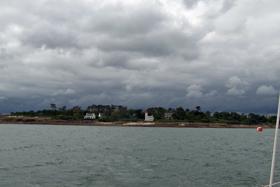
Approaching the O'det River
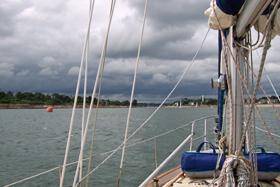
The O'det River

Large sand barge on the O'det

Fish under the boat!

Riverside house on the O'det

An overnight stop

O'det heron

A mooring at Gouesnach
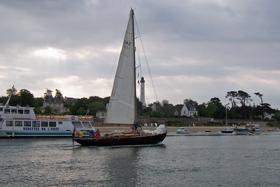
Gipsy Moth III on the O'det

O'det Chateau

Vedette de O'det
Although the river is narrow in places it carries at least two metres, even at low water, for most of its distance to Quimber except for across the final stretches in the Baie de Kerogan. The large open basin, of the Baie, accounts for the very strong tidal effect because the dribble of water flowing through Quimber would hardly be enough to fill a teacup on a daily basis. Although advice was that it would be difficult to find moorings upstream we spent a wonderful week on various marked visitor moorings in the company of fishermen, terns (fishing frantically and continually) egrets and herons (more sedately and with graceful style) and kingfishers, whose colourful streak we caught glimpses of as they raced below the overhanging trees. The most unusual fisherwoman of the week was a vixen turning over the stones on the shoreline in the soft evening sunshine, searching for a tasty morsel, as we enjoyed a locally harvested supper in the cockpit.
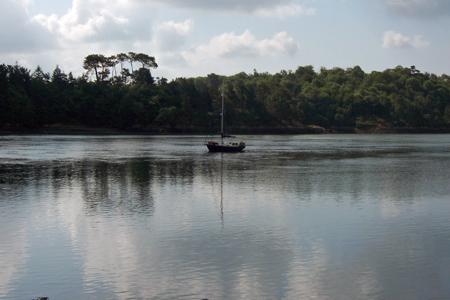
Albertine at anchor in Kerogan Baie
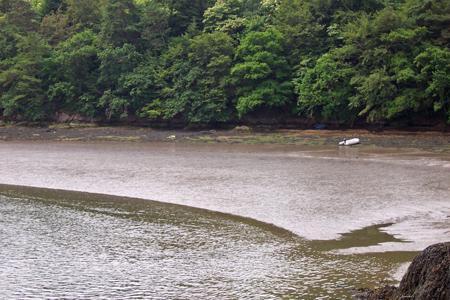
Rosie high and dry
On one occasion in heading off for our daily walk I misjudged the tide, high up the river, and on our return to Rosie she and we were separated from Albertine by the deep clinging mud of the Baie de Kerogan and while awaiting the return of the water we spotted some fresh samphire, which we recognised from our formative years on the Norfolk coast, and that’s what we enjoyed hot and buttered while the vixen went hungry. Being early in the holiday season and still mid June, vedettes were not a problem but we were always keen not to meet either of the two large sand dredgers in the narrower stretches between the deeply wooded slopes. With inadequate charts and only our large scale French road map we were unable to identify the individual magnificent chateaux situated on almost every bend of the river and just had to be content with basking at the bottom of their gardens.

Our view on the River O'det

Pen Duick at Benodet

River O'det again
Our stay at on the Odet coincided with some classic yacht racing and from our buoy in the Vieux Port at Sainte Marine we enjoyed the morning and evening parade of sail as classics such as Pen Duick and Gypsy Moth 3 went to and from their race areas. However, if we were to reach Bordeaux by the end of August we had to move on and decided to miss the delights of Concarneau and Lorient and head slightly further from the shore to the Isle de Groix and Port Trudy. After breakfast and a short session with the engine, to clear the river and immediate shoals, we set the cruising chute which we carried until lunchtime and the arrival of the Vent Solaire. Although the wind which starts in the West at midday and veers to the North West during the early afternoon usually only reaches about Force 4, we find just a little too much for our lightweight chute and our cautious approach where we are invariably under, rather than over canvassed. However, by mid-afternoon we were rafted with another boat on the visitor’s buoys in the outer harbour because all the pontoons in the tidal basin were already full. After getting settled we went ashore for a quiet evening stroll up to Le Bourg (the town) and were amazed at the number of cyclists speeding down the hill heading for their evening vedette back to the mainland. We were expecting to find a delightful offshore island, albeit overcrowded with tourists, but instead found a rather shabby and neglected waterfront and immediate hinterland where “visitor rip-off” was the local intent rather than a friendly welcome. On our return to Albertine, having dodged through the numerous bikes being returned to the four hire shops on the harbour-side, we found that we had become part of an even larger fore and aft moored raft. Although first impressions should not be allowed to cloud judgement we has experienced enough and passage planning for the following morning started in earnest.

Leaving Île Groix

Cruising chute to Île Groix

La Teignouse, Baie de Quiberon
Rather than head down through the offshore islands, of which Belle Isle would be the next, we planned to turn East and tuck around the Quiberon Peninsular and into the extensive marina at Port Haliguen. The final approaches would entail another cardinal identification and tick off exercise through the Passage de la Teignouse but the winds were still light and we would carry a flooding tide through the well marked passage. By 1100 we were off and enjoying another lazy sail leaving the extensive estuary of the River Ethel well to port, and finally rounding up into wind as we passed the port hand mark just South of the delightful little La Teignouse lighthouse, and by 1700 we were safely secured alongside. Port Haliguen was to be another domestics landfall prior to heading across Quiberon Bay and entry into the Golfe du Morbihan. The facilities were good and there were good swimming beaches within easy walking distance and we relished in the improved water temperatures of the Bay rather than the coldness of the water washing in from the Atlantic to the West of the peninsular.
As June drew to a close we reviewed our individual budgets, cruising and housekeeping, to see if we had managed to keep within our joint £1000 (1440 Euro) expenditure limits. Lynda had done well with a slight under spend but Jon’s slight overspend had more than eroded her savings. We knew that the first few weeks would be difficult with a necessary over-reliance on marina facilities and were therefore pleased that we had not had to sacrifice the evening sundowners or some of the other simple pleasures that until now, and when in full employment we had taken for granted.
Offline
#6 2012-01-06 22:49:17
- Jon_Spencer
- Member
- Registered: 2003-11-23
- Posts: 162
Re: ALBERTINE's Log (F34)
The Gulf Of Morbihan And Beyond
Two days later at the beginning of July we slipped out of Port Haliguen for a slow and gentle sail across the Bay with only tidal data forming part of the detailed passage planning and an early evening arrival off Crouesty where we would pick up the leading marks to safely guide us through the narrow entrance into the Gulf. Tidal steams in these narrow confines can reach almost nine knots so once again accurate timing was essential. As the afternoon wore on under a cloudless and wind free afternoon, and with the engine just ticking over, our arrival was slightly early but we picked up the leading marks consisting of large white obelisk and church spire at Baden and pushed the dwindling ebbing neap tide past Port Navalo to starboard and Gregan South Cardinal Mark to port. Local boats knowing the short cuts and making best use of the various eddies soon drew away from us and by the time we turned South past Ile de la Jument they were passing us again but from the opposite direction. We picked up a vacant buoy off the Pointe de Kerners in just under four metres of water within less than a stones throw of the flooding tide which had already reached over three knots surging past in over twenty metres. We spent a quiet evening with the excitement being provided by another competitive game of Scrabble before heading off the following morning to explore the southern fringes of the Gulf.
We had only rounded our first small spit of land and rocks when we came upon a large and unoccupied buoy marked Visiteur and could not resist picking it up with a view to use it as a base from which to explore the southern shores. However, still being in sight of our first night’s mooring we thought we should push on a little further and turned North towards Ile Aux Moines the largest of the public islands and the extensive drying areas to the South would have to await another day. As we arrived under the Pointe de Penhap we found an ideal spot to anchor just to the South of the few moorings that had been laid in the bay, and with good shelter from all directions except the South East. Anchoring however was not going to be an option as the windlass refused to let out any chain although it would recover it. The problem appeared to be electrical with one of the control push switches badly corroded. However, luck was with us and just at the right moment one of the small yachts already on a mooring cast off. Their boat name and that on the mooring did not match so perhaps luck would remain with us and we would be able to fix the problem from relative safety. Three hours later after Lynda had made lunch and cleaned and rewired the anchor switches we used the small jetty to go ashore and explore the southern tip of the island which is a coastal conservation area. There was but one enchanting cottage overlooking the bay and later over supper we were treated to a slightly less than perfect trumpet voluntary from its owner!

Rural lane on Île de Moines

Menhur on Île de Moines
The next morning after another quiet night and with no sight of the buoy’s owner we walked up the spine of the island to the main village at Kergantelec and its little harbour where most of the tourist visitors land by vedette and charge around the island on hired bikes. We walked the coastal footpath past an enterprising young man selling oysters in the shade of pines trees, through narrow rural lanes lines with the bluest of hydrangeas and explored the dolmens of prehistoric sites. These sites like those at Trebueurden all seem to built on the southern fringes of the islands where perhaps they enjoyed the best of the sunshine or perhaps where they were easiest to defend. With the first week of July drawing to a close we decided to head for Vannes, in the North East corner of the Gulf for a couple of days and to try and reserve a berth for a few days the following week.
The approach to Vannes is relatively straight forward but with surging tides and extensive drying areas it is not for the faint hearted. The final entry into the town quay and marina is guarded by a gate, which also maintains a depth of two metres throughout the period of low water and here we made one simple mistake. We aimed for the first gate of the fresh flood in company with at least ten other boats. There was a following wind and vedettes were also manoeuvring in the narrow channel and it was not long before boats ahead of us were aground faced by another small fleet of boats leaving the marina, who of course who had priority of passage. At the last moment we managed to put about and linger slightly downstream and away from the worst of the mayhem. It was a spot from which we could view Ellen MacArthur’s boat B&Q, which we believed was in town for the opening of a new Castronama store which is the French B&Q equivalent. Eventually and without mishap we were berthed and with all the usual domestic considerations of water and electricity connected we settled in to enjoy a few days in the town quay environment. After the peace and quiet of sheltered anchorages in the islands, the glare of street lights at night and the inevitable noise required a little adjustment.
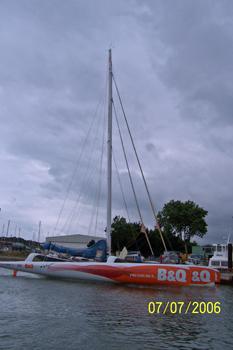
B&Q visiting Vannes
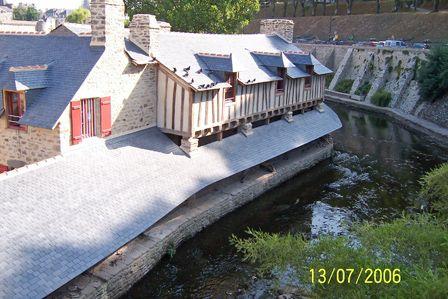
Wash house at Vannes
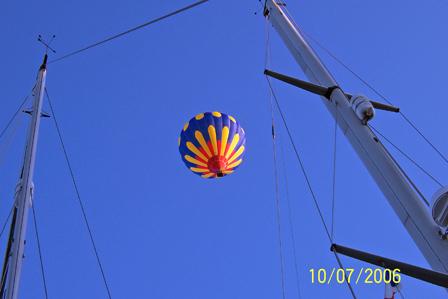
Balloon rides over Vannes
The next day we were in for some disappointment as a major rally was due and we would have to leave before our friends from Warsash arrived for their town twinning meetings between Vannes and Fareham. To the rescue came Michell, the President (Commodore) of the Vannes Association of Sailors, and we were allocated an alternative berth, which had the advantage of being further away from the town centre and a little quieter. From here we were able to join up with Mike and Anna Pinder and their chocolate labrador dog Jasper. On the Sunday, France were to face Italy in the final of the World Cup as very much the favourites and as the celebrations started in earnest during the early afternoon we knew we would be in for a long night. We had supper in the cockpit from where we tried to judge the progress of the match and were surprised when we walked into the town to find the match still evenly balanced. We joined a lively audience outside a café who became very subdued when the French captain was sent off, and as the exciting stalemate ran into extra time and a penalty shoot out even the partisans had resigned themselves to the inevitable Italian victory. Vannes is a medieval town steeped in history which was reflected in the pageant and parade on Bastille Day which itself culminated in a fantastic firework display from the ramparts of the old town. The show of music and light went on to far after midnight and the crowd of tens of thousands took hours to disperse. After eight days of eating, drinking and festivities it was time to return to the solitude of the islands of the Morbihan.
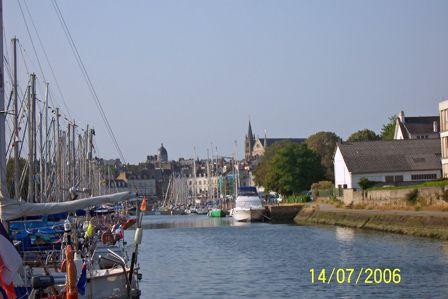
Looking from the marina to the town of Vannes
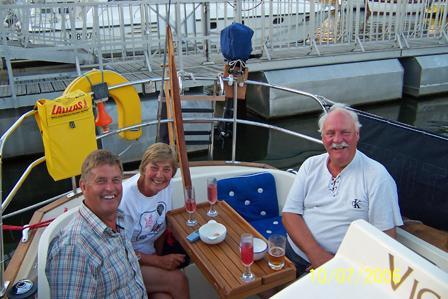
Mike and Anna on board Albertine
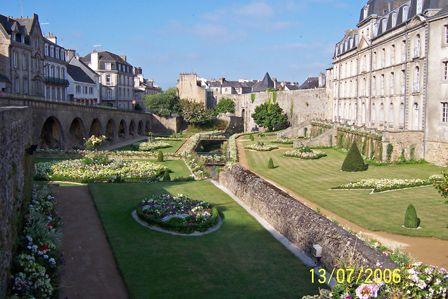
The gardens by the ramparts, Vannes
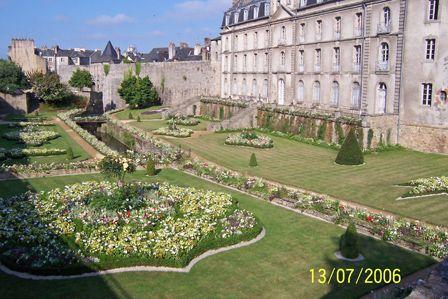
The rampart gardens, Vannes
On rising tides we explored further shallow areas to the East of the Gulf and found what was to prove to be our favourite spot in the lee of Ile de Araz, the second largest of the public islands. The holding appeared to be good and we were well protected from most winds. The little village, which had all the necessary amenities, and was only a short walk from the jetty started the day gently just before nine with many of the locals waiting outside the shop for their daily bread and other essentials. The shop never opened on time but that did not seem to matter as locals and obvious long term holiday home residents caught up on gossips since previous holidays. We spent several lazy days of walking and swimming and on the eastern end of the island discovered a magnificent holiday complex devoted to the “Orphans of the Customs Service”. We also used the anchorage from which to explore the remainder of the islands making sure we caught the best of the swift flowing tides to carry us from sheltered eddy to sheltered eddy. Although the holding in our favourite anchorage appeared to be good we spent one exciting day watching French boats dragging their anchors across our usually sheltered bay in what were only modest winds. One boat managed to become trapped by another boat’s very short mooring rope caught between its rudder and keel. Having watched all attempts to free themselves I laid out my spare fisherman’s anchor, chain and rope from which they were able to winch themselves free and we enjoyed the resultant bottle of wine with supper. The Ile de Araz boasted a lovely little tidal mill which was fast falling into dereliction and no longer ground the island’s flour. Here we were also surprised to find Ibis feeding at the waters edge along with the Egrets and Herons. We had not expected to see these until much further South.

The sea mill on Île d'Arz

View from Albertine, Île d'Arz

Views from Île d'Arz

Ibis on the shore, Île d'Arz

Ibis, Île d'Arz

Île d'Arz

Île d'Arz
With island explorations, afloat and on foot, exhausted we weighed anchor and headed for the western end of the Gulf on the tidal roller coaster, and the Auray River. We had expected the Morbhian to be over-crowded but the river, as with the Gulf, provided ample opportunities to pick up vacant moorings and there was space to anchor. For the first night we picked up one of ten visitor moorings laid at the confluence of the Auray and Bono rivers and were able to visit both towns by using Rosie, which spared us the need to worry about tight corners and low bridges. It was market day in Auray when we landed at the Benjamin Franklin Quay and can fully understand its reputation for being the largest and most colourful market in Brittany; there was everything including a spare pair of reading spectacles for me. I had dropped my other pair overboard the previous day as they slipped out of my shirt pocket while picking up the mooring buoy. We spent two days at this tranquil spot which at 8.10 Euros per night represented the best value for money on the cruise so far. The Harbour Master even brought us a personal copy of the weather forecast during his morning round of the moorings. This indicated that the high pressure was about to break so we had to decide on our next move which was to catch the tide to the South East and the Vilaine River.

The bridge at Bono

Bono Harbour
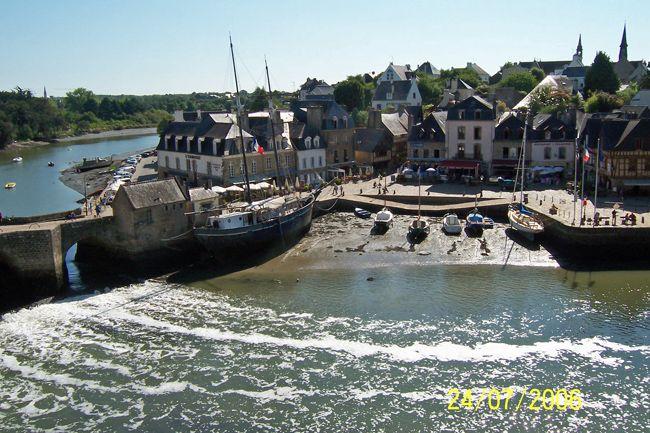
Benjamin Franklin Quai, Auray

Bridge over the River Auray
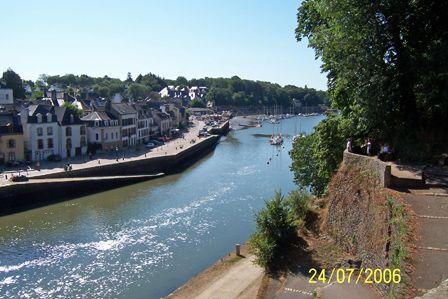
River Auray
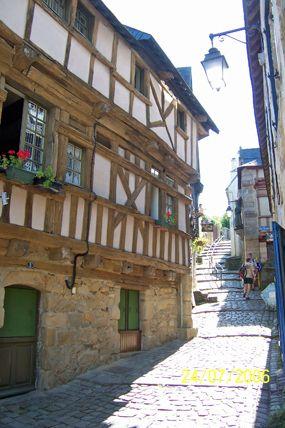
Timbered buildings, Auray

Towards Benjamin Franklin Quai

Narrow street, Auray
We had another lazy sail in light winds and showers and entered the river via the sea lock just before the weather broke with a magnificent thunderstorm. The Vilaine (meaning deep) was once a tidal river, but in 1970 a dam was built across its mouth to transform it into a vast fresh water reservoir which serves the needs of a huge chunk of South Brittany while at the same time providing a wonderful non-tidal boating and leisure facility. We anchored for the first night just a stone’s throw from the shore in over 10 metres of water and the following morning slipped into the riverside marina at La Roche-Bernard. As we were securing the mooring lines we heard the hail of “Albertine” and there, right behind us, were Mike and Anna Pinder and Jasper, who we had last seen at Vannes two weeks before and who now moored alongside. We enjoyed supper together in the old quarter and town square and the following morning were off again to explore the non-tidal reaches of the Vilaine River.

Navalo Lighthouse outbound, Gulfe du Morbihan

Fishermen in the River Vilaine
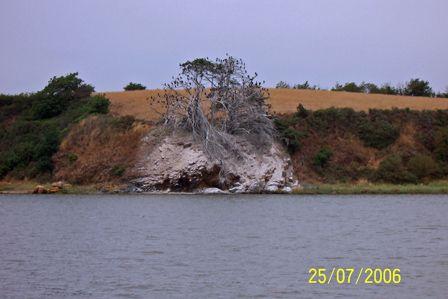
River Vilaine

Rehello, Vilaine River
By lunchtime we had found a secluded spot just North of Marazan and dropped anchor close to the river bank. We could have run out a kedge anchor to hold us close to the bank but the river was so wide that it was unnecessary because we were well clear of the fairway and with the exception of the very large, and almost compulsory, sand dredger there was only light lesiure traffic passing. The afternoon was spent watching the graceful flight of Black Kites soaring in the thermals and in the early evening dusk, while out in Rosie, we thought we spotted two Otters out fishing in the twilight. This was our first otter sighting and we could have mistaken them for some other mammal but their continual diving for prey and strong tail strokes convinced us they were Otters. Early the following morning just after dawn they appeared again, this time close to Albertine and in the improving light were even more convinced that our identification had been right but with increasing movement on the river they were soon lost to sight under the overhanging trees and behind the reeds.
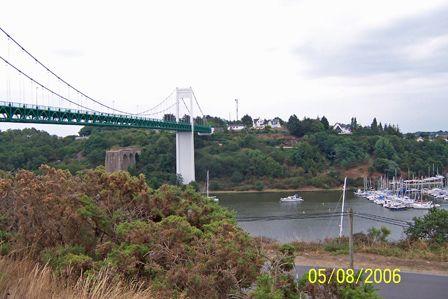
Bridge over the Vilaine River

Early morning mist on the Vilaine River
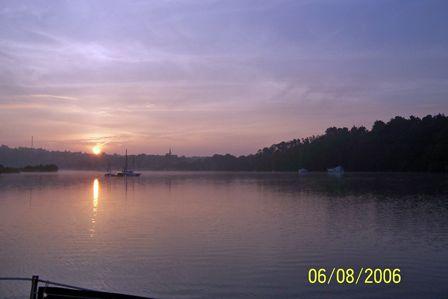
Sunrise over La Roche Bernard

View towards La Roche Bernard

Reiux Quarter, La Roche Bernard
Later in the morning we moved on under engine and briefly stopped at the little marina at Foleux before anchoring, out of the fairway, just below the village of Beganne. In the afternoon we again used Rosie to further explore the river banks and just before supper were joined by John and Faith for drinks. Our wakes had first crossed the month before in Trebeurden when we were all stood on the bows of John’s boat “Arrested” while he cut away fishing net wrapped around his prop shaft. We enjoyed their company and toasted their planned marriage for the following year. The next short hop took us past through the swing bridge at Pont de Cran and just before some heavy and squally showers enveloped us we came alongside the small pontoon, just under the ruins of an old Châteaux, at Rieux. Here we stayed completely free of mooring fees for a couple of days before moving on to the Port at Redon.
Redon is a bustling little town that sits astride the Vilaine and the Brest to Nantes canal, and has a mainline train (TGV) station from which Paris can be reached in just three hours. Although our mooring was right in the centre of town, with main road and canal traffic passing close to our bows and stern, the old quay and historic buildings brought a quiet atmosphere to our busy surroundings. As usual the efficient tourist office provided us with the necessary detail of what we should see and it was not long before we were out and about.

Motorway bridge over the Vilaine River

Combine harvesters racing
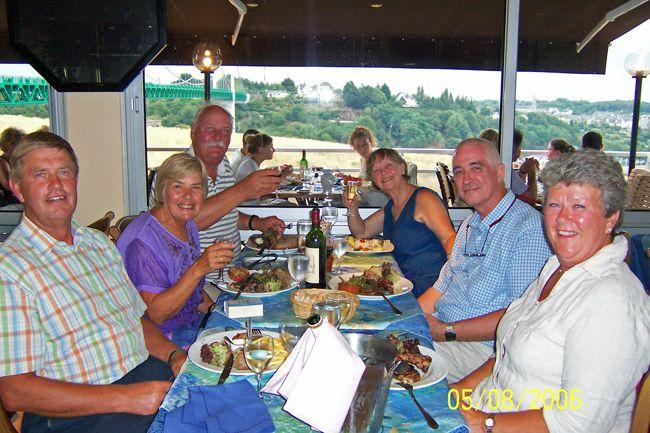
Warsash Sailing Club friends dining out at La Roche Bernard
Redon lacks some of the character of La Roche Bernard or the prosperous atmosphere of Vannes but it has all the normal requirements close at hand. With July now turned to August we headed back downstream to catch sight of the Kingfishers, who appeared quite at home close to the large Intermarche where we shopped having made a short passage from Rieux in Rosie. We berthed for several days on Rieux pontoon, to catch up on the various domestic chores, before meandering through Beganne and back to anchor in Otter country just above La Roche Bernard.
During the second week of August our peace and solitude was brought to a temporary end with a phone call from home and our need to return at very short notice. Rapid phone calls to Brittany Ferries and the Harbour Master at Redon enabled us to catch the train from Redon the following morning, via Rennes and Lison to Cherbourg, and by ten that evening we were home, having left Albertine in safe hands for a couple of weeks. With our immediate problems dealt with we returned all too briefly to Albertine and moved her back to a swinging mooring at La Roche Bernard and an afloat winter berth for a fraction of the cost of a Hamble River mooring. With a complete short term revision of our cruising plans, we must soon decide on our medium term plans for next Spring.
We set off at the end of May with clear intentions, a simple plan and modest budget. We enjoyed ourselves far more than we thought we would. We settled well to the gentle pace of life and shared the tasks on board according to our individual strengths, mainly on Lynda's side, and my weaknesses, especially with anything mechanical. With plenty of time to spare the weather never caused us a real problem, and there were always plenty of forecasts available to help with the planning before each short passage. As planned we spent about half the time at anchor and avoided the expense of marinas at the height of the French holiday season and completed all our activities within our £1000 monthly budget.
Offline
#7 2012-01-07 13:13:52
- Jon_Spencer
- Member
- Registered: 2003-11-23
- Posts: 162
Re: ALBERTINE's Log (F34)
Over Winter And The Return
When we left Albertine on the Vilaine River in the Summer of 2006 we had little idea of how the next few months and the Winter would pan out. Would we sort out our domestic problems at home and be able to return to our original plans and reach the Mediterranean, or would we need to re-consider our whole approach? Over the coming months we were to test most of the transport methods and routes between the Vilaine and Hamble rivers with varying degrees of success.
Having initially managed to return home at very short notice from Redon, by train and ferry, our trip back to France was by plane from Southampton to Rennes, where friends collected us in their car and transported us the 50 odd miles back to Redon, where we collected Albertine and returned to La Roche Bernard.
Our first requirement was to find a Winter berth for Albertine where she would be safe and secure. The Harbourmaster’s team were excellent and we were soon allocated a river mooring at the very reasonable price of 500 Euros for seven months.

Our earlier short notice trip home was the result of crisis management, but after a week of pre-winter maintenance we were ready to again return home in a slightly more orderly fashion. We had proved the route, the ferry was booked from Cherbourg and we only had to catch the early morning bus from La Roche Bernard to Redon, to meet up with the train. At the start we were nearly left stranded in the driving rain because the bus that we had planned to catch from La Roche Bernard in the early morning only ran on Mondays, and it was Tuesday! However, we managed to arrange for a taxi to take us the 20 miles to Redon and arrived in time, only to find that the train timetable had changed to the Winter service the day before. It was a little like being on a demanding passage; we were soaked to the skin and things were not going quite right. Instant decisions were required and within ten minutes we boarded a train for Le Mans with the prospect of a change of train there, before heading for Caen. At least we had a change of clothes with us so made ourselves comfortable before testing the efficiency of Brittany Ferries with our changed plans; they were needless to say completely supportive and at no extra cost. We eventually arrived home in Sarisbury Green about an hour ahead of our original schedule.
Life at home without Albertine was frustrating and it was not long before all the jobs in the apartment were completed, and so back to work; to face some fresh challenges, fill the day, and of course earn some pocket money and add to the pension pot. We were however determined to return to the Vilaine without too much of a break and made our plans for trips over Christmas, Easter and the following early Summer.
Albertine's Return Route 2007
When we left Albertine snug on her river mooring in September, we noticed that several of the boats were wrapped in pea netting, and others festooned in bright strips of material and compact disc reflecting the sunlight. We had not seen many seagulls on boats so thought it was all a bit un-necessary. How wrong we were. On our return over the Christmas holiday, we found that Albertine had been a favourite roost for the local cormorants! They are obviously birds of habit and must have roosted in the same direction, because we had large quantities of regurgitated fish on the port decks and guano to starboard.

It took most of our Christmas break to clean it all it all off, but at least we had planned to use the comfort of accommodation ashore. By the end of the holiday we had enjoyed some sparkling Winter sunshine cruising up the river to give the engine and propulsion gear a good run, and ensure that the batteries were fully charged. We waved goodbye to Albertine, this time festooned in pea netting, and headed back home in our car via Calais and Dover. Slightly longer than other routes but with a company car under our bottoms we potentially saved about £100 on other alternative routes, and the convenience was a vast improvement on the weekly bus that we had missed from La Roche Bernard. The money saved was not wasted but invested in wine!


Winter turned to Spring and we were soon back on Albertine for Easter. The pea netting had successfully kept the cormorants, and other large birds at bay, and with the warmer weather we were keen to enjoy time on board attending to the usual annual maintenance list, as well as spending a few days on the river revisiting old haunts from the previous Summer. We were also able to secure a pontoon berth at La Roche Bernard until our planned return in late May, although we had still not decided what the Summer would bring. We kept our options open, with car and four passengers booked via Dover and Calais, and a plan for simple cruising for two or three, with others moving the car from port to port and returning via Calais and Dover two weeks later. Where Albertine would have reached by that time was still undecided. Friends joined us on what was for them, a short booze cruise, and for us a delivery trip in a now fully laden car.
By the time we returned to La Roche Bernard in late May at least we had decided that we would head for home, by day sailing rather than passage making. It had taken us five months of bliss to get down there, in short hops, and we now had ten days for the return passage, with a less than promising weather forecast.
Our departure from the Vilaine just before mid-day was in crystal sunshine and we made our way out through the sea lock at Arzal and hoisted all sail, for the first time in almost nine months. During the afternoon the wind died and engine assistance was needed to reach Port Haliguen before the tide changed. The previous Summer we had seen Pen Duick in the Odet river at Saint Marine, but now we were treated to seeing her under full sail, ghosting her way up to La Trinite. It was great to be back under sail and after a short overnight stop we caught the middle of the ebb out through the Teignouse Passage and the flood straight up to Benodet and Saint Marine.
We had some difficulty with buoy recognition as we approached the Odet, but motored in without real incident. The barometer was dropping and we wondered if our planned hop, the following day, to St Evette, to position ourselves to shoot the Raz de Sein would still be possible.
The following day the barometer, although low at 1004, had steadied, the sky looked settled, the early morning forecast on Radio 4 seemed reasonable so we headed out for the Pointe de Penmarch.

The tide was still ebbing hard with the wind steadily increasing against it. We had reefed the main and started the engine to punch our way through the broken water, but when the bottom fell out of the barometer we turned and headed back to Saint Marine where we spent the next couple of days looking out across the wind swept bay. Our decision to return had been right, as during the next day two people lost their lives off that exposed West coast. Our passage clock was ticking and we could ill afford time in port if we were to day sail. However, two days later, at dawn, we were off, around the Pointe on an easy reach, caught the flood perfectly on our approach to the Raz de Seine and were in Camaret for supper with barely a splash on deck.
The following day was looking uncertain but the increasing wind from the South-West would provide us with a great reach up through the Chenal du Four, and we might even make the Morlaix estuary before dark, provided we could survive the wind over tide situation in the Rade de Brest early the following morning.
The beat was every bit as demanding as we thought it would be, but as the flood started we slipped past Les Vieux Monies and into the Chenal du Four. L'Aberwrach was skipped and as we rounded Ile Vierge Light our speed over ground continued to increase to a healthy eight knots.

Our sights were now set beyond the Morlaix estuary and in the early dusk were through the small gap between Ile de Batz and the mainland on a flood that seemed to have been running in our favour ever since we entered the Chenal du Four. With a fantastic sunset over our stern the wind dropped away and we motored into Trebeurden under the lee of Ile Milliau and were snug within the marina for hot chocolate and a well deserved sleep.
The following morning we refuelled, checked the forecast, and sailed off leaving the delights of the pink granite coast in our wake. Our passage took us to the North, leaving the Sept Isles well to starboard, and a planned landfall of St Martins Point on the South East tip of Guernsey. We were now becoming accustomed to long sailing days, but will never really be happy with corkscrewing over increasing swell on a broad reach, where hand steering becomes essential as the tiller takes on more and more weather helm. However, St Peter Port was reached with nothing more than tired arms and the outer harbour was as empty as we have ever seen it. We even arrived so late, and left so early the following morning, that we were unable to pay our mooring fees!
At 0600 we set off up the Little Russell pushing the last of a foul tide shortly after dawn with the expectation of reaching Cherbourg for lunch. The Alderney Race poses no challenges for Albertine and we felt like a slingshot as we popped out of its Northern reaches recording eleven knots over the ground in a splendid force four on the beam. A quick flick through the waypoints and suddenly the Needles Fairway Buoy seemed within easy reach, and as the forecast was to deteriorate the following day, we decided to carry the slingshot effect out into the Channel. We were well into the East going shipping lanes before we lost the final effects of the Race and with it the wind. The engine was pressed into service, and with the extra electrical power we reminded ourselves of the capabilities of the radar.

As we reached the West going shipping stream, vessels were massed on the visible and radar horizons and we timed our opportunity to slip just astern of two huge ore carriers, under ballast, before being pressed by smaller and faster ships in their wakes. At one stage we had eleven vessels within our four-mile radar rings and were brimming with confidence in the clear sunshine. Perhaps we might adopt a slightly different stance within thick fog! By the time we reached the Needles at 1730 the wind had increased enough to make progress under sail again and we slipped in through Hurst Narrows and down the Western Solent to arrive at Warsash Club pontoon by 2100 and in time for a drink at the bar.
Albertine and her crew were home within six manageable day sails and ready for a Summer on the Solent.
Throughout the remainder of the Summer we joined rallies with other friends from our Association, with members of both Warsash Sailing Club, and the Royal Naval Sailing Association and even managed the odd week away on the North Brittany coast. Albertine was pressed into service as a Committee Boat for various Dinghy Open Race Meetings, and as I pen these last few lines we have just returned from an afternoon basking in bright sunshine and the Autumnal Equinox is almost upon us.
At the beginning of the Summer we had no firm plans, but as events unravelled Albertine gave us all the options we needed to enable us to enjoy ourselves. Towards the end of Cowes Week, and with the Fastnet Race being postponed, we had slipped away through the Channel Islands to weather the storm on good foods and good wine, but that’s all in another log entry for another time.

Offline
Pages: 1